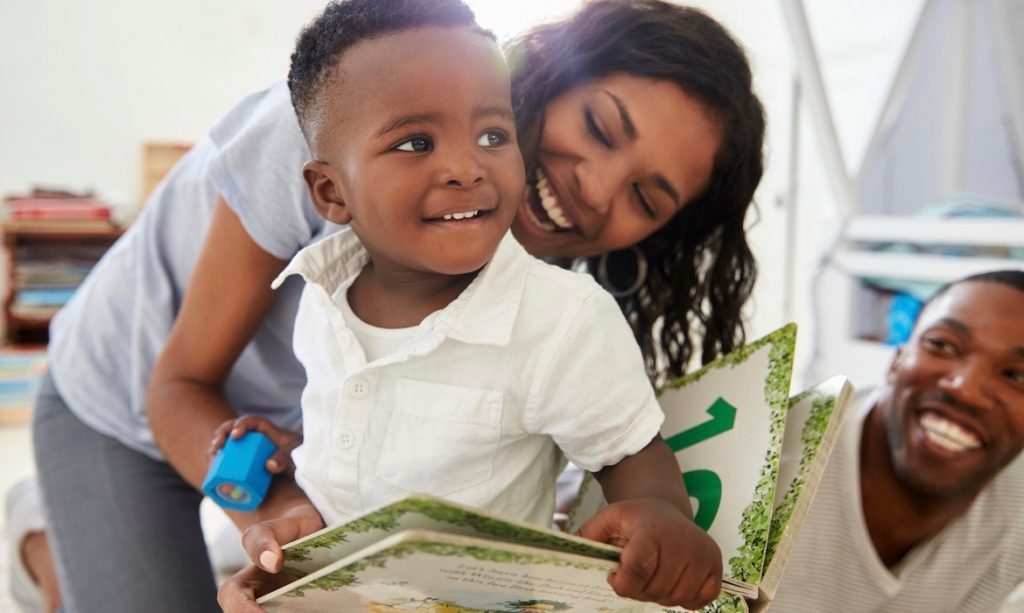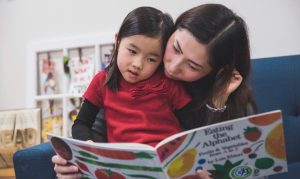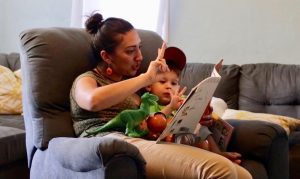Picture books are a great tool for discovering mathematics. Books focused on counting are some of the earliest books to which young children are exposed, and there is no shortage of such books at local libraries, with literally thousands of counting books published in the U.S. alone. [1]
From our review of 120 popular counting books, we learned that counting books differ from each other on many dimensions. They differ not only in their content, but also in the ways they portray numbers and what to count. [2] These variations in counting book features are not necessarily good or bad, because what is best will vary from child to child and across periods of development. For these reasons, we do not set out to endorse or discourage use of any specific counting books. Instead, we suggest that there is value in exposing children to many different counting books, and we offer suggestions about which book features to pay attention to when reading counting books with young children.
Learning to Count
All of the counting books we reviewed include some representation of number. Although the numbers in most of these books usually appear in increasing order (such as from one to 10), the range of numbers in some counting books may be more limited or expansive; may appear in descending or sporadic order; and may even involve skip counting with larger numbers. We found that although 76% of the books we reviewed had at least some instances where increasing numerical sequences occurred across consecutive pages, 41% of the books had at least some pages in which numbers occurred out of sequence. (These percentages do not equal 100% because some books had combinations of both types of pages.)
Counting books can serve different purposes depending on the child’s understanding of numbers. For example, counting books initially may be a tool for helping children learn to count, whether that means learning the counting word sequence, the purpose of counting, and some early number words, such as one, two, or three. Then, for children who already have some understanding of counting, these books can provide an opportunity to practice counting and deepen knowledge of counting principles, larger numbers, and numerical properties.
Children who are well aware of what numbers are and how to count can still benefit from these books, especially books that portray how adding one item leads to the next number in the counting sequence. Among the books we reviewed, 91% focused on an inclusive range of numbers, such as all of the numbers between one and 10, as opposed to numbers out of sequence, such as all of the numbers from one to 10 and also 20.
For a child who is still learning the verbal counting sequence, it makes sense to choose counting books in which numbers appear sequentially and in ascending order rather than books where numbers are presented out of sequence for at least part of the book.
Matching Number and Illustration

It is especially important for young learners to know what they are expected to count on a page if they are to learn what the number word or numeral means. Nearly half of all books we reviewed included examples where the numeral on a page did not match the number of items pictured. Often there was a good reason for the discrepancy, but the rationale may very well escape the minds of young children learning to count!
Sometimes a page in a book has more items displayed than the numeral on the page suggests. For example, in the image to the right labeled, “3 baby ducks,” there are actually four total ducks on the page. Adult readers know why the numeral “3” appears on this page of four ducks, but a child may think that the symbol (3) means four.
A total of 42% of books we reviewed had pages with this kind of discrepancy. However, these discrepancies can still offer math learning opportunities. A book that always shows one more of something on the page provides a great opportunity to explain that each number word in a sequence is exactly one more than the number that comes before it. For instance, on this page, we could explain why the number three appears on the page and how many total ducks there are when we also count the parent duck.

Sometimes it might seem that there are fewer items on the page than the numeral suggests, such as when the items to be counted are grouped into sets. For instance, in the image to the right, of three baby ducks, the two sets of frames are so prominent that a child might not realize that the individual ducks correspond to the numeral “3.” Among the books we reviewed, 11% had pages with this kind of discrepancy. This discrepancy can also offer a math learning opportunity because a book that depicts numbers divided into smaller sets provides an opening to talk about addition.
Counting Book Challenges
Assuming that the numeral on the page matches the set size to be counted, pay attention to how well children can detect which set of items are meant to be counted. This might depend on how easy it is to see what gets counted and the child’s ability to keep track of what is being counted.
We found three features of illustrations that might interfere with children’s counting and offer ways to turn them into math learning opportunities.
Random Arrangements of Sets. In 32% of the books we reviewed, the item sets to be counted are arranged in a straight line, which makes it easier to track them when counting, compared to items that are arranged somewhat randomly or grouped altogether. In 84% of the books, at least some sets were linearly arranged, usually sets of smaller numbers, because five or fewer things will easily fit in a row, like the four ducks in the picture above.
But when sets are in a group and not in a row, it may be more challenging for young children to keep track of where they started and what they already counted. Ninety percent of the books we reviewed had randomly arranged sets on at least some pages, so readers may want to be aware of the need to help children keep track of what has been counted on these pages. The ability to keep track of a task involves self-monitoring, a component of executive function skills.
Overlapping Visuals. Across the books we reviewed, 59% of pages displayed visual items in a group as separate and distinct objects (such as in picture A, below). But on 30% of the pages, the items were grouped close together, and on 10% of the pages, the items were so close together that they overlapped and obscured each other (such as in pictures B and C, below).

Adult readers can watch for these instances and be aware that sometimes a child may need help seeing all of the items that are meant to be counted on a page. When you see a crowded or overlapping set of items, use this as an opportunity to reinforce counting exactly the specific number of items. For example, if you show the third picture of apples to a child and the child counts only four apples in total instead of five, try responding with, “I think there are supposed to be five apples, like the number here shows. Let’s try to find them all. If you found four, there must be one more. Maybe one is hiding.”
Distractions. The counting books we reviewed differed in terms of whether the illustration displayed only the items meant to be counted, or whether they displayed other visuals that may or may not have been relevant to the counting exercise. We hesitate to say that extra visuals are all truly distracting, because the visuals might be important for promoting story engagement, which in turn may facilitate children’s learning about counting. [3] Whether these extra visuals help or interfere with learning depends on many factors, such as whether the same set of items that is meant to be counted is displayed on every page. Twenty-three percent of the books we reviewed had six or more distractors on at least 75% of their pages, whereas 15% had no distractors on at least 75% of their pages. Adult readers may want to anticipate that extra visuals can be distracting to young learners, and use them as another opportunity to help children focus on and enjoy finding what they need to count. A review of visual options pictured below illustrates that whether counting all three apples is easy or fun may depend on the child, the adult reader, and the story context in which the visual distractors appear.

Counting to Learn
Counting is not simply a single skill that a child either lacks or masters. It emerges alongside children’s knowledge of what numbers are, what number words mean, and why we count. The skills supported by children’s knowledge are reflected in children’s ability to recite the number word sequence, keep track of what they’ve counted, and report how many are in a set. Counting books can play a role in helping children acquire this knowledge and develop these skills. [4]
However, there are limitations to counting books. Only 3% of the counting books we reviewed actually provided explicit or even implicit opportunities to help children learn counting principles like cardinality. Until that rate increases through counting books published in the future, adults may want to watch for opportunities to emphasize that counting informs us how many items are in a set. Relatively few of the counting books we reviewed (about 5%) explicitly involved operations or decomposition, or other complex mathematics concepts.
By repeatedly engaging in counting, particularly with books that emphasize these counting principles, children learn how numbers are related to each another. Therefore, children who already understand some aspects of counting may still benefit from interaction with counting books and might especially enjoy the challenges some counting books pose in finding all items in a set or predicting what number comes next. A child’s current knowledge will help determine exactly what they learn from a counting book, and the same child may acquire different knowledge upon later revisiting some of the same books. The world of storybooks is rich with learning opportunities, and the same is true for books that are counting books!



